By Geoff Hancock
Introduction
Can you catch bass on a fly? Aren’t bass usually out of range to get them with a fly rod? You can only catch the smaller bass when fly fishing – can’t you? It can be difficult enough to catch bass from the shore by the more conventional rod and line methods so why bother making it more difficulty by trying to catch them on the fly rod?
In the past I often heard questions and comments like these whilst fishing on the UK sea shore and though it still happens, it happens less so now. In contrast, during almost 30 years that I have fly fished the east coast of America, such comments have been rare with regard to the various species available from Florida to Cape Cod. It appeared to me that there was a much greater general acceptance of saltwater fly fishing on the other side of the Atlantic and I guess this may be one reason why so many tackle and method developments have their origins over there.
At home, TV, DVD, internet and print media are increasingly influencing the idea that bass can be caught on flies from the UK shoreline and it appears that there is some movement in angling activity towards saltwater fly fishing and consequential growth of specialist guiding services. Of course, it has been known for a very long time that bass make good fly fishing targets. I have been catching them since the days of hollow glass-fibre fly rods and others were catching them long before my time on Earth began.
The questions and comments at the start of this article are based on many common misconceptions originating from just as many sources. Even today, some media articles specifically regarding fly fishing for bass indirectly enforce some of these misconceptions. The most common ones being the catching of smaller fish (usually by advocating fishing in the calmer estuarine type locations where aggregations of smaller fish may dominate population structure) and that bass are only worth targeting with the fly under specific circumstances such as when they can be seen attacking bait fish.
I hope within the next few sections I can convey useful information that may dispel some of these misconceptions and enable the reader to gain a basic understanding of the requirements to start fly fishing for bass or to strengthen the understanding of those that have already started but wish to understand more.
Places and Times
As with all forms of angling the most important aspect to the sport is to locate the fish or at least places where bass are likely to visit. In this way fly fishing is no different from lure or bait fishing. Whilst wading or fishing from the shore you can fly fish the surf, rough ground, deep gullies, deep inshore drop-offs, sand bars, rips or virtually all locations where bass may feed. Fish location is a subject in its own right and deserves a separate article all of its own and will not be covered in detail here, however, I would like to address a few issues that are related to places and times:
a) Season
For my home waters of North Wales I have a self imposed window of bass fly fishing opportunity that starts in May and finishes in October. In the main, July August and September provide the best averaged return for effort applied, however, subject to ones personal willingness to expend increased effort for potentially reduced returns fish can regularly be caught in May, June and most certainly in October. This does not mean to say that you can not catch bass on the fly outside these months in North Wales.
The further south you fish in the UK the longer the effective window of opportunity you get for fly fishing for bass such that the south coast may provide realistic opportunity for all but the first couple of months in the year.
b) Coloured Water
The more coloured the water the less effective I find fly fishing is for bass and I would move location rather than wasting effort in reduced visibility conditions. Wind, heavy rain run-off, wave action, water depth, tide movement and type of sea bed substrate can all effect water clarity as can heavy algal blooms at certain times of the year. If shallow areas hold cloudy water then look for deeper water with a clean rock substrate or shorelines within the lee during high wind periods. When some colour is present but not enough to change location then try more brightly coloured flies or black flies to improve visual location and try fishing them slightly slower than for clean water.
c) Fish Close-in
On first view it appears sense to say that the more water you can cover with your bait or lure the more chance you have at success. If you consider this more deeply you then come to the view that the more water you can cover that contains bass the more success you may have. We all know that with fly fishing you are mostly confined to fishing within 30 metres of your rod top and perhaps 10 or 20 metres if conditions are bad, you are using very large flies or your casting ability has not yet been fully developed. The aim with fly fishing for bass is then to find shoreline that is likely to hold bass within your casting distance. Luckily, one of the most convenient aspects of bass behaviour is that some have a pre-disposition to follow the shoreline as they move and to be drawn to inshore ‘structure’ that can be reached by the fly fisher with or without the aid of wading but very often right within the littoral zone of the shore between high and low water levels. Structure provides environments for bass foods and/or areas where bass can set ambush. Structure may take many forms from boulders to sand bars and troughs to rock gullies or patches of rough ground within an area of lesser features. In simplistic terms these areas provide a ‘difference’ against a more even background and new entrants to the sport would not go far wrong by first looking for these features, within their casting range, as places where to start fishing.
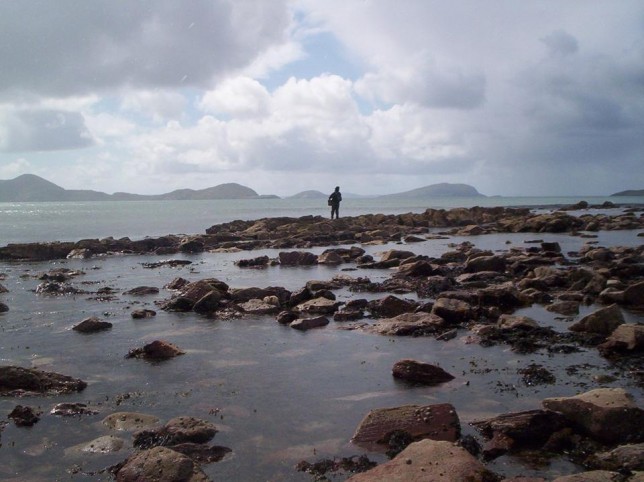
Alternatively, one could seek out ‘pinch points’ on the shoreline where bass may be focussed to when moving between various feeding locations. Rocky points and gullies between bays or sand bars provide such ‘pinch points’. At these places the fly fisher would fish for a selected period of tidal range and try to tempt passing bass that were anticipated to move around or through the area of focus.
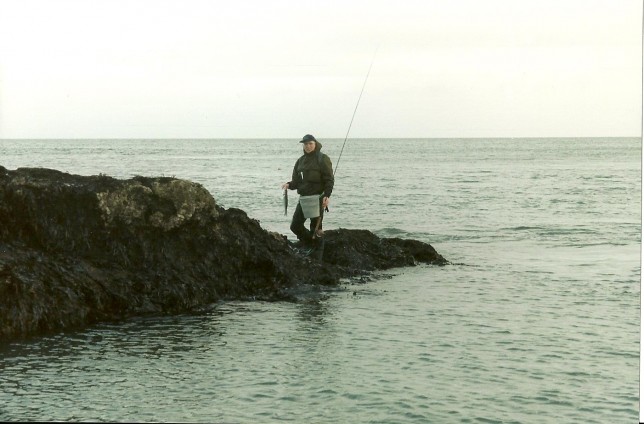
d) Light Levels
In shallow water locations, especially where the ability for bass to flee into nearby deep water does not exist then bright, overhead sunshine can prevent bass from venturing into too shallow water – say less than 1m in depth. During overcast days or when the sun is lower on the horizon then bass seem more confident to move into very shallow areas. During darkness or before the sun appears over the horizon bass will move very close to shore indeed, no matter what the water depth as long as they can push themselves through it. This makes fly fishing especially productive during these low light levels and most productive during the dark, though few anglers wish to venture forth at night on the rough ground suited to bass or indeed have developed the confidence that they can catch bass on fly in the dark. I fully understand the aesthetic pleasure of watching the fly line unfold, of seeing the bass hit the fly and landing the bar of silver in the light of the sun, made even more pleasant by the connection you have with the water when wading. However, more and bigger fish WILL be closer at night and available to the fly fisherman.
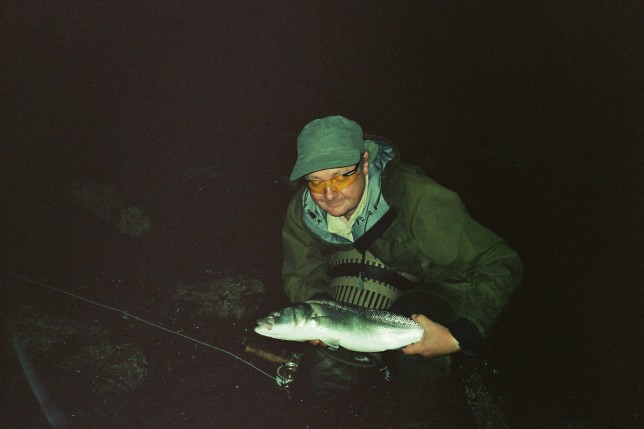
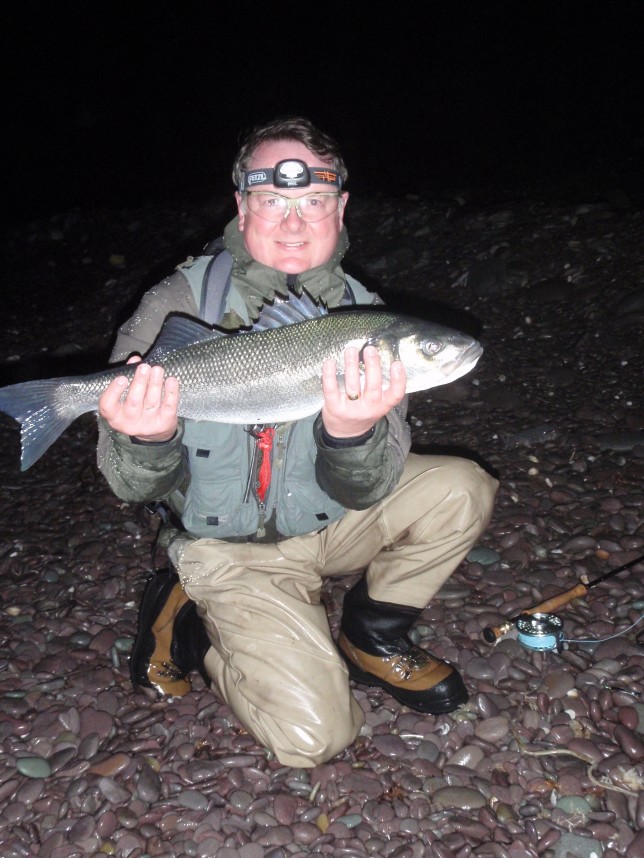
Equipment and Flies
There are two main routes to the uptake of saltwater fly fishing for bass in the UK, the first is from sea anglers who perhaps wish to try fly fishing along with their lure fishing, and the second is from the freshwater game fishing sector when salmon or trout anglers look to expand their horizons. For those with existing freshwater fly tackle it is relatively easy to at least sample the joys of saltwater fly fishing by utilising the more sturdy pieces of their freshwater tackle with appropriate rinsing at the end of every saltwater session. However, if they decide to concentrate effort on saltwater fish then they may be best served by acquiring tackle specifically made for the rigours of the saltwater environment and designed to be able to cast large, bulky and sometimes heavy flies into strong winds. Anglers moving to saltwater fly fishing for the first time have a multitude of saltwater tackle options open to them depending upon their budget and personal preferences on features and performance. Because tackle choice is such a personal thing I do not promote individual products here, however, I set out the basic requirements I believe are important in the tackle to be used:
a) Rods and Reels
For me the most important aspect of a saltwater fly rod, for use in UK bass fishing, is its ability to throw bulky flies into a strong wind. When conditions are calm and you are trying to present small sand eel fly patterns then this requirement seems superfluous, however, wind can increase very quickly and a shoal of mackerel or other sizeable bait fish can turn up requiring suitable tackle and large fly patterns to exploit the situation. Fast taper, tip action rods provide this requirement for me. An 8wt would cover the majority of conditions, however, I also fish a 7wt if conditions are forecast to be very calm and a 9wt if conditions are extremely rough or I am fishing deeper water with heavy, fast sinking lines and where larger Pollock may also turn up.
Robust reservoir trout rods can be used successfully for bass, especially in calmer conditions and if not using very large fly patterns on fast taper saltwater lines. Using such a rod would prevent the initial requirement to buy a specific saltwater rod until the angler had decided if saltwater fishing was to be taken up more seriously. A word of caution is needed here regarding the severe level of exposure of tackle to physical damage caused by clambering over weedy, slippery rocks, down small cliffs, through gullies etc. and from the corrosive nature of salt. Always rinse rods off after saltwater use and make sure salt is not caked in reel seat crevices. A soft toothbrush is especially good at cleaning guides and reel seats. Expect to break a rod or two if you take up saltwater fly fishing in earnest!
Bass are generally solid fighters and whilst they often give good account of themselves they are unlikely to run long distances into fly reel backing. In fact, because the fly angler tends to hook them at close quarters then backing is rarely seen. As a consequence reels do not need to be the highly refined models more suitable for hot saltwater species that can rapidly run into large amounts of backing. More important though is the need for reels, in particular, to be resistant to saltwater corrosion and to being bashed on rocks. Wide arbour reels make life much easier and can be useful when used to catch other saltwater fish that do run, such as mullet. 100m of backing (saltwater proof) is more than enough to deal with even large bass but make sure you periodically strip the line from the reel and clean line and reel under a running tap of warm water using a soft toothbrush to clean the ports.
b) Lines and Leaders
Whilst freshwater lines could be used for occasional saltwater sessions they usually lack the short, fast tapered heads that enable larger flies to be shot into strong winds. I would not be sure about the longevity of these lines either, especially if used in the surf. The UK saltwater angler requires coldwater lines for their fishing. Warm water, tropical lines go stiff as a board in our waters and are comparatively useless. The vast majority of my bass fishing is undertaken in water that can be fished with floating lines where water depth is less than 3m. Delicacy of presentation is of little consequence, especially in windy conditions or in fishing the surf. Good saltwater lines are available via the internet and need not cost much and I prefer to purchase these lines then discard after a season of heavy abuse.
Leaders are one area where I would indulge in high quality product. 7.5ft or 9ft knotless tapered fluorocarbon leaders are used with floating lines. I choose 16lb tippet leaders to which I attach, via a loop to loop connection, about 2 feet of 16lb fluorocarbon tippet. The tippet gradually reduces in length as flies are replaced and then a new section of tippet can be added Tough, fluorocarbon leaders usually last a season during which time I will have re-tied the terminal loop knot a few times to maintain a secure connection with the tippet. Eventually the leader becomes shorter at which point I save these highly tapered pieces for use on fast sinking lines. I have not found bass to be leader shy at all and the fluorocarbon is used more for its durability and nature to help sink a fly through surface layers than for its ‘invisible’ qualities. The shorter (7.5ft), more tapered leaders are used when wind levels are a particular problem and you simply need to get a fly out into the water in the teeth of a gale.
Having tried many ways to construct line and leader systems I now rely on just one method. I tie a large loop in the backing (using a Bimini twist) and affix a heavy braided loop to the reel end of the fly line using 2 or 3 nail knots that are lightly covered with UV curing glue. The backing is then loop connected to the fly line. This system enables lines to be changed easily and forms a smooth connection if fish do run into the backing bringing the connection through rod guides. This process is repeated at the leader end of the fly line, again using a heavy braided loop so that the leader can be added via loop to loop connection. As described previously, the tippet is added via loop to loop connection using non-slip mono loop knot on leader and tippet and finally the fly is tied to the tippet, again using a non-slip mono loop knot. This is a very simple set-up, has high strength value and has served me well even in tropical conditions with very powerful fish.
c) Flies and Techniques to Fish Them
There are more fly patterns available to saltwater anglers than can possibly be used in many seasons of fishing and whilst it can be great fun experimenting with these there is a more important consideration than pattern alone. This consideration is how the pattern is fished. I mainly use 2 patterns of fly, these being sand eel and ‘bait fish’ patterns that are tied in weighted, un-weighted and floating styles to cover the various ways in which these should be fished. In general, most of the flies are tied on size 1, 1/0 or 2/0 hooks and fly size is matched to the rod weight used and conditions in which the flies are fished.
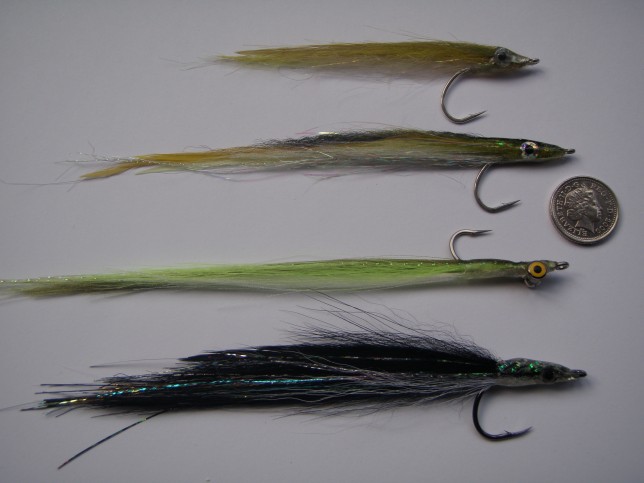
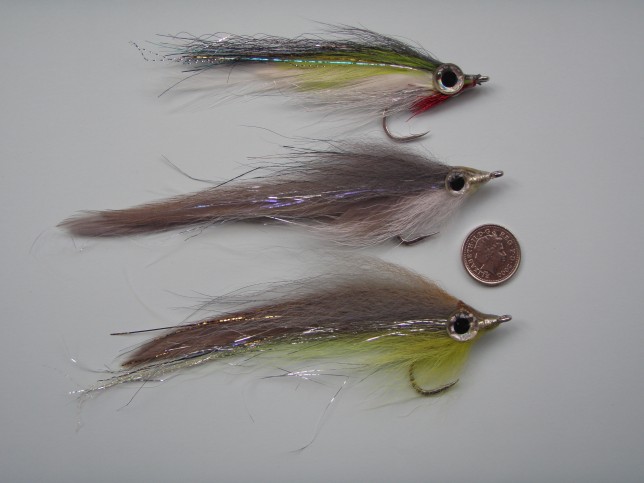
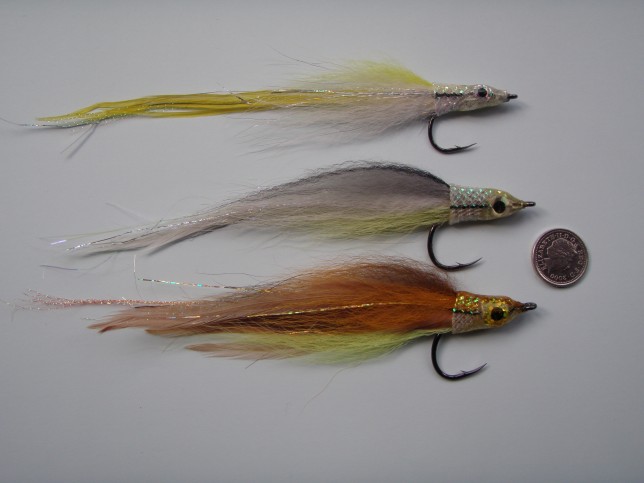
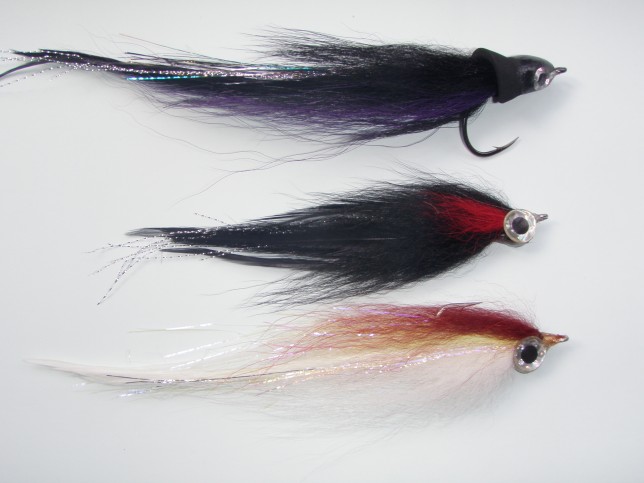
When using floating lines, weighted flies that fish in ‘bend back’ style (hook pointing upwards) are frequently used especially in areas with significant ‘snags’ and / or current, with the extra weight allowing the fly to fish at depth as it swings in the flow rather than skating just underneath the surface. In addition, if fished on floating line in water from 1m to 4m in depth a sink and draw action can be imparted that proves highly attractive to bass.
Un-weighted flies can be made to ‘flutter’ at a constant depth and position by using suitable line / sink tip combinations in areas of slight or moderate flow, just as bait fish can be seen to hold in the current. This technique is especially useful at the tip of rocky points or off sand bars where current flow is concentrated and bait fish gather.
A technique that we have found to be particularly successful is using highly buoyant flies on fast sinking lines and short leaders (1.5m) both on sandy, fast sloping beaches and in deeper water (>7m) locations usually off steeply sloping rocky shores. Very fast sinking lines are required to get the flies down, which are then fished slowly back with the fly hovering just above the bottom. This is also a good method in surf type conditions with lateral water flow where the fast sinking line provides some mechanism to get the fly down without being caught up and thrown about in the wave action. Takes are particularly savage in these conditions rapidly taking up any slack line or bow that may develop with this type of fishing.
d) Accessories
It should go without saying that the fly angler should always wear polarising sun glasses during the day or safety glasses at night but this is especially important for saltwater fly fishing where flies can be large and heavy and wind direction and gusts variable. I also find that wearing a hat provides some protection from a clout by a weighted fly!
My first 20 years of saltwater fly fishing was undertaken without the use of a line tray. I started to use these about 10 years ago and would not wish to be without one now; I wish I had used them from the start! They are most helpful, especially in the surf and prevent a great deal of line damage.
Certain locations are so slippery with weed covered boulders and deep rock pools that having a wading stick can turn an otherwise unfishable location into one that is accessible. These locations often produce good fishing.
Summary
Having covered a few basic concepts of saltwater fly fishing for bass it should now be clear that you can catch them on the fly from the shore and not just the small ones.
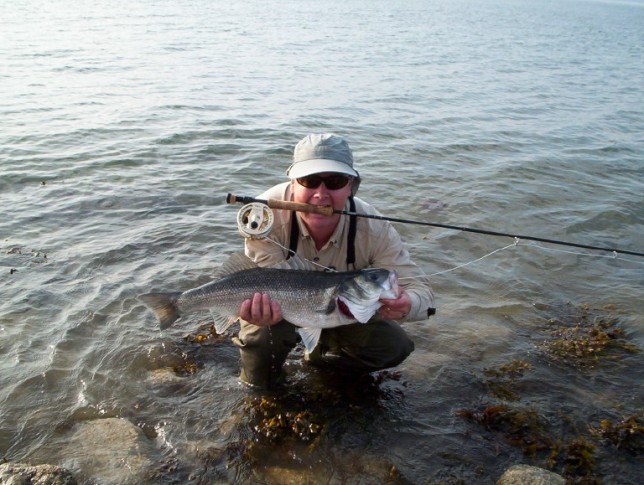
Choose a location with structure and if possible with moving water at a point where bass may be focussed. Fish this location at low light periods as long as the water is not too coloured and during several stages of the tide. This approach will lead to success.
End.